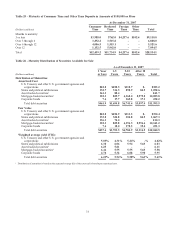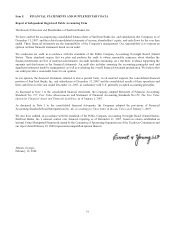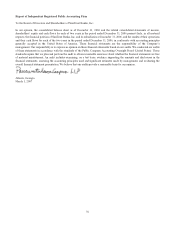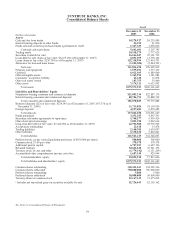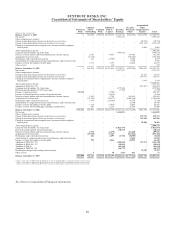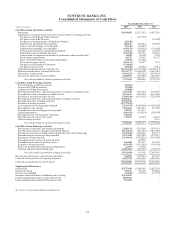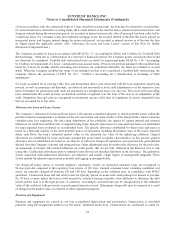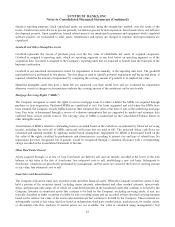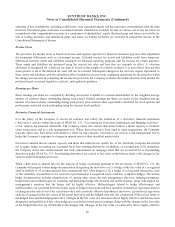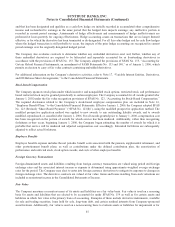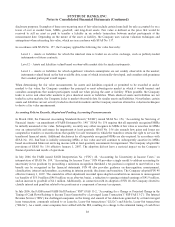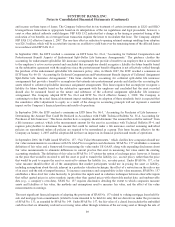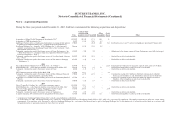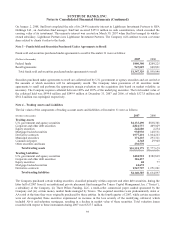SunTrust 2007 Annual Report Download - page 95
Download and view the complete annual report
Please find page 95 of the 2007 SunTrust annual report below. You can navigate through the pages in the report by either clicking on the pages listed below, or by using the keyword search tool below to find specific information within the annual report.SUNTRUST BANKS, INC.
Notes to Consolidated Financial Statements (Continued)
Securities that are purchased beneficial interests or beneficial interests that continue to be held in securitized financial assets
(other than those of high credit quality or sufficiently collateralized to ensure the possibility of credit loss is remote) are
accounted for under EITF 99-20, “Recognition of Interest Income and Impairment on Purchased Beneficial Interests and
Beneficial Interests that Continue to Be Held by a Transferor in Securitized Financial Assets”. Accordingly, the Company
evaluates whether there has been an adverse change in the present value of estimated cash flows from the present value of
cash flows previously projected, in order to determine if an other-than-temporary impairment exists.
Nonmarketable equity securities include venture capital equity and certain mezzanine securities that are not publicly traded
as well as equity investments acquired for various purposes. These securities are accounted for under the cost or equity
method and are included in other assets. The Company reviews nonmarketable securities accounted for under the cost
method on a quarterly basis and reduces the asset value when declines in value are considered to be other-than-temporary.
Equity method investments are recorded at cost adjusted to reflect the Company’s portion of income, loss or dividends of the
investee. Realized income, realized losses and estimated other-than-temporary unrealized losses on cost and equity method
investments are recognized in noninterest income in the Consolidated Statements of Income.
Loans Held for Sale
Loans held for sale are recorded at either the lower of cost or fair value, applied on a loan-by-loan basis, or fair value if
elected to be accounted for under Statement of Financial Accounting Standards (“SFAS”) No. 159, “The Fair Value Option
for Financial Assets and Financial Liabilities.” Origination fees and costs for loans held for sale recorded at the lower of cost
or fair value are capitalized in the basis of the loan and are included in the calculation of realized gains and losses upon sale.
Origination fees and costs are recognized in earnings at the time of origination for newly-originated loans held for sale that
are recorded at fair value. Fair value is derived from observable current market prices, when available, and includes loan
servicing value. When market data is not available, the Company estimates fair value based on third party indications of fair
value, which may also include adjustments made for specific loan characteristics. Adjustments to reflect unrealized gains and
losses resulting from changes in fair value and realized gains and losses upon ultimate sale of the loans are classified as
noninterest income in the Consolidated Statements of Income.
The Company transfers certain residential mortgage loans, commercial loans, and student loans to a held for sale
classification at the lower of cost or fair value. At the time of transfer, any losses are recorded as a reduction in the allowance
for loan losses with subsequent losses recorded as a component of noninterest income in the Consolidated Statements of
Income. The Company may also transfer loans from held for sale to held for investment. At the time of transfer, any
difference between the carrying amount of the loan and its outstanding principal balance is recognized as an adjustment to
yield using the interest method, unless the loan was elected upon origination to be accounted for at fair value under SFAS
No. 159. If a held for sale loan is transferred for which fair value accounting was elected, it will continue to be accounted for
at fair value in the held for investment portfolio.
Loans
Loans that management has the intent and ability to hold for the foreseeable future or until maturity or pay-off are considered
held for investment. The Company’s loan balance is comprised of loans held in portfolio, including commercial loans,
consumer loans, real estate loans and lines, credit card receivables, nonaccrual and restructured loans, direct financing leases,
and leveraged leases. Interest income on all types of loans is accrued based upon the outstanding principal amounts, except
those classified as nonaccrual loans. The Company typically classifies commercial loans as nonaccrual when one of the
following events occurs: (i) interest or principal has been in default 90 days or more, unless the loan is well-secured and in
the process of collection; (ii) collection of recorded interest or principal is not anticipated; or (iii) income for the loan is
recognized on a cash basis due to the deterioration in the financial condition of the debtor. Consumer and residential
mortgage loans are typically placed on nonaccrual when payments have been in default for 90 and 120 days or more,
respectively.
When a loan is placed on nonaccrual, unpaid interest is reversed against interest income. Interest income on nonaccrual
loans, if recognized, is either recorded using the cash basis method of accounting or recognized at the end of the loan after
the principal has been reduced to zero, depending on the type of loan. If and when borrowers demonstrate the ability to repay
83


